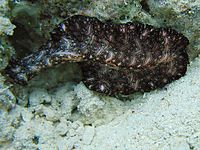Platyzoa facts for kids
Quick facts for kids Platyzoa |
|
|---|---|
 |
|
| Pseudobiceros bedfordi (Bedford's Flatworm) | |
| Scientific classification | |
| Kingdom: | |
| Subkingdom: | |
| (unranked): | |
| Superphylum: |
Platyzoa
Cavalier-Smith, 1998
|
| Phyla | |
|
|
The Platyzoa are a group of tiny animals, often called "flat animals." They are part of a larger group known as protostomes. A protostome is a type of animal that develops its mouth first during its early growth.
Scientists use a system to sort living things into groups. This system is called classification. Platyzoa is a special group that is even bigger than a phylum. A phylum is a major division of the animal kingdom, like how mammals or insects are big groups.
What Are Platyzoa?
The idea of Platyzoa was first suggested by a scientist named Thomas Cavalier-Smith in 1998. He noticed that certain small animals shared similar features. He thought they should be grouped together.
These animals are usually very small, and many of them have flat bodies. This is why they are called "flat animals."
Types of Animals in Platyzoa
The Platyzoa group includes several different kinds of animals. Here are some of the main ones:
- Flatworms (Platyhelminthes): These are simple, soft-bodied animals. Many flatworms live in water, but some can live on land. They are known for their flat shape.
- Gastrotrichs (Gastrotricha): These are tiny, worm-like animals that live in water. They have hair-like structures called cilia that help them move.
- Gnathifera: This is a larger group within Platyzoa. It includes several very small animals that often have special jaw-like structures.
- Rotifers: These are microscopic animals found in fresh water. They have a crown of cilia that looks like a spinning wheel, which helps them eat and move.
- Acanthocephalans: These are also known as spiny-headed worms. They are tiny and live as parasites inside other animals.
- Gnathostomulids: These are very small, worm-like animals that live in marine sand. They have unique jaw structures.
- Micrognathozoa: These are extremely tiny animals, only found in cold springs. They have complex jaw systems.
- Cycliophora: These are microscopic animals that live on the mouths of lobsters. They have a unique life cycle.
Why Are Platyzoa Important?
Scientists study Platyzoa to understand how different animal groups are related. By looking at their DNA and how they develop, scientists can learn more about the history of life on Earth. Grouping these animals helps us see the connections between them, even if they look very different.
See also
 In Spanish: Platyzoa para niños
In Spanish: Platyzoa para niños

